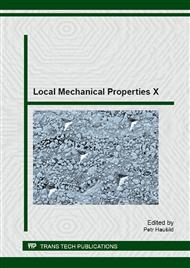p.31
p.35
p.39
p.43
p.47
p.53
p.61
p.65
p.69
The Effect of Microstructural Features on Mechanical Properties
Abstract:
Every material is structured in its unique way and has its own recognizable microstructure. There are a number of approaches in establishing the relationship between mechanical properties and microstructure of a material, but none of them is universal and correlation free, probably because of luck of attention to the sub-grain structure. The possibility of calculating the hardness number using only geometric sizes of microstructural formations is discussed in this paper, where the grain is meant to be a container of the two most frequently occurred shapes in the microstructures globula and lamellae.
Info:
Periodical:
Pages:
47-50
Citation:
Online since:
March 2014
Authors:
Keywords:
Price:
Сopyright:
© 2014 Trans Tech Publications Ltd. All Rights Reserved
Share:
Citation:


